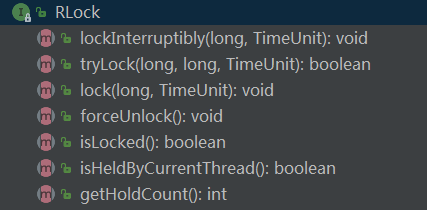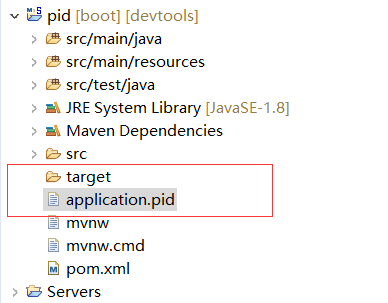redisson锁继承implements reentrant lock,所以具备 reentrant lock 锁中的一些特性:超时,重试,可中断等。加上redisson中redis具备分布式的特性,所以非常适合用来做java中的分布式锁。 下面我们对其加锁、解锁过程中的源码细节进行一一分析。
锁的接口定义了一下方法:
分布式锁当中加锁,我们常用的加锁接口:
boolean trylock(long waittime, long leasetime, timeunit unit) throws interruptedexception;
下面我们来看一下方法的具体实现:
|
1
2
3
4
5
6
7
8
9
10
11
12
13
14
15
16
17
18
19
20
21
22
23
24
25
26
27
28
29
30
31
32
33
34
35
36
37
38
39
40
41
42
43
44
45
46
47
48
49
50
51
52
53
54
55
56
57
58
59
60
61
62
63
64
65
66
|
public boolean trylock(long waittime, long leasetime, timeunit unit) throws interruptedexception {
long time = unit.tomillis(waittime);
long current = system.currenttimemillis();
final long threadid = thread.currentthread().getid();
long ttl = tryacquire(leasetime, unit, threadid);
// lock acquired
if (ttl == null) {
return true;
}
time -= (system.currenttimemillis() - current);
if (time <= 0) {
acquirefailed(threadid);
return false;
}
current = system.currenttimemillis();
final rfuture subscribefuture = subscribe(threadid);
if (!await(subscribefuture, time, timeunit.milliseconds)) {
if (!subscribefuture.cancel(false)) {
subscribefuture.addlistener(new futurelistener() {
@override
public void operationcomplete(future future) throws exception {
if (subscribefuture.issuccess()) {
unsubscribe(subscribefuture, threadid);
}
}
});
}
acquirefailed(threadid);
return false;
}
try {
time -= (system.currenttimemillis() - current);
if (time <= 0) {
acquirefailed(threadid);
return false;
}
while (true) {
long currenttime = system.currenttimemillis();
ttl = tryacquire(leasetime, unit, threadid);
// lock acquired
if (ttl == null) {
return true;
}
time -= (system.currenttimemillis() - currenttime);
if (time = 0 && ttl < time) {
getentry(threadid).getlatch().tryacquire(ttl, timeunit.milliseconds);
} else {
getentry(threadid).getlatch().tryacquire(time, timeunit.milliseconds);
}
time -= (system.currenttimemillis() - currenttime);
if (time <= 0) {
acquirefailed(threadid);
return false;
}
}
} finally {
unsubscribe(subscribefuture, threadid);
}
// return get(trylockasync(waittime, leasetime, unit));
}
|
首先我们看到调用tryacquire尝试获取锁,在这里是否能获取到锁,是根据锁名称的过期时间ttl来判定的(ttl
下面我们接着看一下tryacquire的实现:
|
1
2
3
|
private long tryacquire(long leasetime, timeunit unit, long threadid) {
return get(tryacquireasync(leasetime, unit, threadid));
}
|
可以看到真正获取锁的操作经过一层get操作里面执行的,这里为何要这么操作,本人也不是太理解,如有理解错误,欢迎指正。
|
1
|
get 是由commandasyncexecutor(一个线程executor)封装的一个executor
|
设置一个单线程的同步控制器countdownlatch,用于控制单个线程的中断信息。个人理解经过中间的这么一步:主要是为了支持线程可中断操作。
|
1
2
3
4
5
6
7
8
9
10
11
12
13
14
15
16
17
18
19
20
21
22
23
24
25
26
27
28
29
30
31
32
|
public v get(rfuture future) {
if (!future.isdone()) {
final countdownlatch l = new countdownlatch(1);
future.addlistener(new futurelistener() {
@override
public void operationcomplete(future future) throws exception {
l.countdown();
}
});
boolean interrupted = false;
while (!future.isdone()) {
try {
l.await();
} catch (interruptedexception e) {
interrupted = true;
}
}
if (interrupted) {
thread.currentthread().interrupt();
}
}
// commented out due to blocking issues up to 200 ms per minute for each thread:由于每个线程的阻塞问题,每分钟高达200毫秒
// future.awaituninterruptibly();
if (future.issuccess()) {
return future.getnow();
}
throw convertexception(future);
}
|
我们进一步往下看:
|
1
2
3
4
5
6
7
8
9
10
11
12
13
14
15
16
17
18
19
20
21
|
private rfuture tryacquireasync(long leasetime, timeunit unit, final long threadid) {
if (leasetime != -1) {
return trylockinnerasync(leasetime, unit, threadid, rediscommands.eval_long);
}
rfuture ttlremainingfuture = trylockinnerasync(commandexecutor.getconnectionmanager().getcfg().getlockwatchdogtimeout(), timeunit.milliseconds, threadid, rediscommands.eval_long);
ttlremainingfuture.addlistener(new futurelistener() {
@override
public void operationcomplete(future future) throws exception {
if (!future.issuccess()) {
return;
}
long ttlremaining = future.getnow();
// lock acquired
if (ttlremaining == null) {
scheduleexpirationrenewal(threadid);
}
}
});
return ttlremainingfuture;
}
|
首先判断锁是否有超时时间,有过期时间的话,会在后面获取锁的时候设置进去。没有过期时间的话,则会用默认的
|
1
|
private long lockwatchdogtimeout = 30 * 1000;
|
下面我们在进一步往下分析真正获取锁的操作:
|
1
2
3
4
5
6
7
8
9
10
11
12
13
14
15
16
17
|
rfuture trylockinnerasync(long leasetime, timeunit unit, long threadid, redisstrictcommand command) {
internallockleasetime = unit.tomillis(leasetime);
return commandexecutor.evalwriteasync(getname(), longcodec.instance, command,
"if (redis.call('exists', keys[1]) == 0) then " +
"redis.call('hset', keys[1], argv[2], 1); " +
"redis.call('pexpire', keys[1], argv[1]); " +
"return nil; " +
"end; " +
"if (redis.call('hexists', keys[1], argv[2]) == 1) then " +
"redis.call('hincrby', keys[1], argv[2], 1); " +
"redis.call('pexpire', keys[1], argv[1]); " +
"return nil; " +
"end; " +
"return redis.call('pttl', keys[1]);",
collections.singletonlist(getname()), internallockleasetime, getlockname(threadid));
}
|
我把里面的重点信息做了以下三点总结:
1:真正执行的是一段具有原子性的lua脚本,并且最终也是由commandasynexecutor去执行。
2:锁真正持久化到redis时,用的hash类型key field value
3:获取锁的三个参数:getname()是逻辑锁名称,例如:分布式锁要锁住的methodname+params;internallockleasetime是毫秒单位的锁过期时间;getlockname则是锁对应的线程级别的名称,因为支持相同线程可重入,不同线程不可重入,所以这里的锁的生成方式是:uuid+":"threadid。有的同学可能会问,这样不是很缜密:不同的jvm可能会生成相同的threadid,所以redission这里加了一个区分度很高的uuid;
lua脚本中的执行分为以下三步:
1:exists检查redis中是否存在锁名称;如果不存在,则获取成功;同时把逻辑锁名称keys[1],线程级别的锁名称[argv[2],value=1,设置到redis。并设置逻辑锁名称的过期时间argv[2],返回;
2:如果检查到存在keys[1],[argv[2],则说明获取成功,此时会自增对应的value值,记录重入次数;并更新锁的过期时间
3:key不存,直接返回key的剩余过期时间(-2)
原文链接:https://www.roncoo.com/article/detail/133572
相关文章
- 64M VPS建站:如何选择最适合的网站建设平台? 2025-06-10
- ASP.NET本地开发时常见的配置错误及解决方法? 2025-06-10
- ASP.NET自助建站系统的数据库备份与恢复操作指南 2025-06-10
- 个人网站服务器域名解析设置指南:从购买到绑定全流程 2025-06-10
- 个人网站搭建:如何挑选具有弹性扩展能力的服务器? 2025-06-10
- 2025-07-10 怎样使用阿里云的安全工具进行服务器漏洞扫描和修复?
- 2025-07-10 怎样使用命令行工具优化Linux云服务器的Ping性能?
- 2025-07-10 怎样使用Xshell连接华为云服务器,实现高效远程管理?
- 2025-07-10 怎样利用云服务器D盘搭建稳定、高效的网站托管环境?
- 2025-07-10 怎样使用阿里云的安全组功能来增强服务器防火墙的安全性?
快网idc优惠网
QQ交流群
-
2025-05-29 82
-
2025-05-29 91
-
2025-05-29 23
-
2025-05-29 25
-
2025-05-29 26












